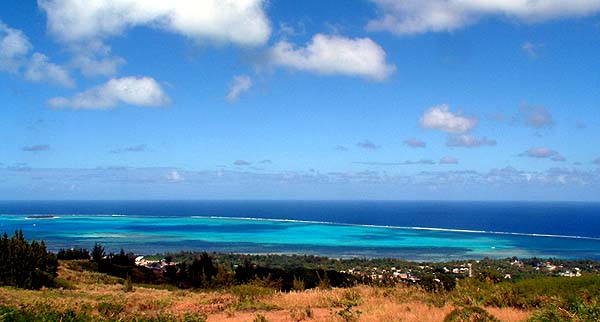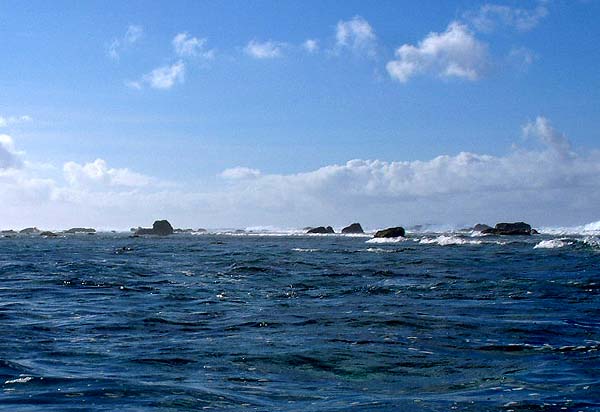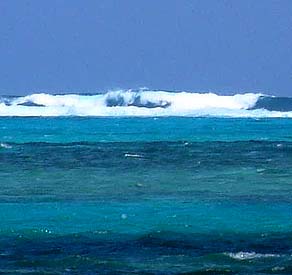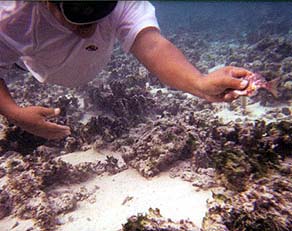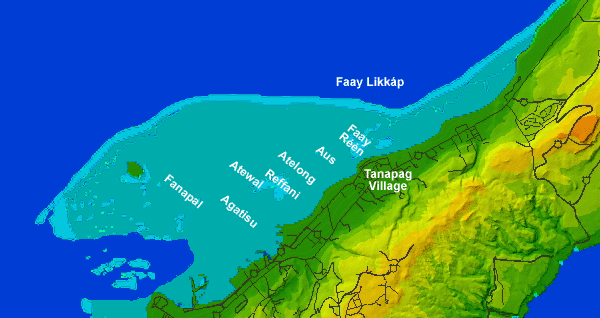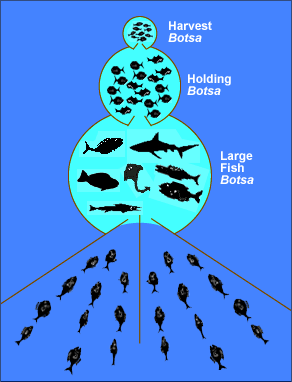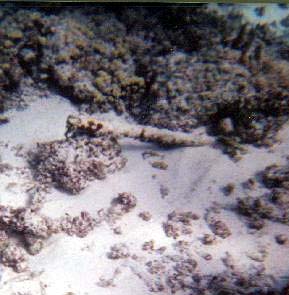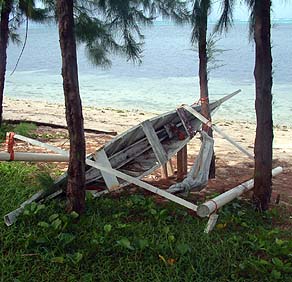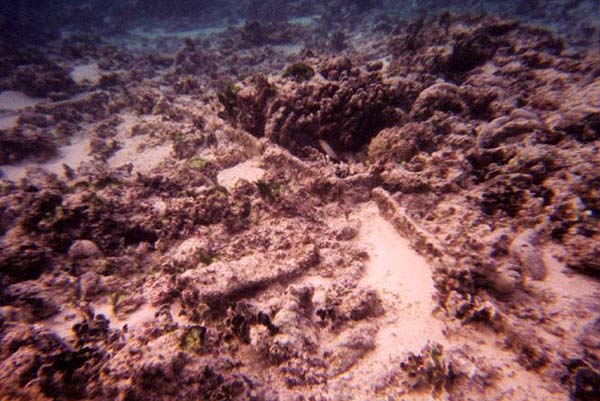 |
 |
 |
|||||
|
|
|
|
|
|
|
|
|
|
|
|||||||
|
|
|
|
View of the reef-enclosed lagoon off Tanapag .
|
|
“Most of the people of Tanapag came from the central Carolines," Ben reminds us, "and were moved by some traders to Unai Babuen on the island of Tinian. From Tinian they made it up to here, and the primary reason for not staying on Tinian, was because the fishing ground there was terrible. There wasn’t any good area to fish. So when they traveled up by canoe to Saipan, they looked around here, and they saw this beautiful reef system, together with the sea grass and the seaweed, and this is what they fell in love with. They really appreciated the structure of the coral system.”
|
||
|
|
||
“The zonation here is not typical oceanic zonation. Looking out into the northwest direction, this black and brownish looking color on my left is all flowering plants, sea grass, and algae. And on my right is all coral growth, except the near shore would be all sea grass and algae. "These are excellent nursery grounds. This is where fish will come in to spawn: the fingerlings come in and grow here, and after the transitional period, they will eventually move out to the breakers out near that big rock. "And that’s mostly where people go out and fish. They fish for big snappers, grouper, parrot fish, and sturgeon fish. Just inside the breaker. Spear fishing and net fishing."
|
|
|
"The bright blue area in-between, the lighter, aqua color, is devoid of sea grass, and very little coral is growing there. So it has a sandy bottom. And that color is actually from the sky. It gets its color from up there, but because there’s no coral, no grasses growing, the white sandy bottom reflects that kind of color. “This is a barrier reef, and it’s a gentle slope. It doesn’t come out and just drop down. On the eastern part of the island, where it’s a fringing reef, there’s a dramatic drop, unlike the western part of the island just outside of the barrier reef. When you get beyond those breakers, you can see the slope going downward, and it might extend out to about 1,000 feet, and it’ll still have a 300 feet bottom."
|
|
|
|
|
“The breakers comes right on top of the coral reef. It’s too shallow to surf out there, and most surfers would get badly damaged when they come in, because it’s all coral reef there. The breakers there are big primarily right after typhoon. The swells goes up to 10-15 feet. Today it’s a little bit choppy, we’ll probably get 10 feet, but most of them will be between 3 and 5 right now."
|
||
|
|
||
|
“In summer, there’s hardly any waves at all. Sometimes you don’t see any white foam coming in, because there’s hardly any waves. And that’s the time we go outside the reef and fish outside, and catch bigger fish. To get outside the reef now, we have to go all the way out the harbor and around. On many occasions during the summer time we would jump the reef. We just paddle our boat or get a pole and just jump the reef with the boat, or sometimes we just tilt the engine up and motor out. We do that to save gasoline, and to save distance. "But normally, when you have 3 to 5 feet, maybe up to 7 feet, we will not be able to get out of that reef, so we’d have to take our boat all the way down past Managaha and get out of the harbor that way.”
|
“From November all the way to March, the current prevails: undertow near the shore, and close to the barrier reef the current goes between 3 to 10 knots. Usually, when the tide is coming up, you find that the current is quiet strong, and also when the tide is going down the current is very strong. "During low low tide, the current is much slower, and we’re able to swim against it, and that’s about the time that we go out fishing during winter. So, naturally, for protection and maybe enhancement, the fish will grow a little bit bigger, because we don’t go every day or every other day. This is the time that is good for the fish. They grow to reproductive age."
|
|
|
“The Carolinians named various places on the reef in the Carolinian language. The big rocks out there are called Faay Likkáp. It means ‘Big Rock,’ or Acho’ Dánkolo in Chamorro. Faay means the rock, which is actually coral. In the old days we used pole to push our boat. These are all paddling type boat, and once we crossed this big rock out there, we’re supposed to throw rocks, and ask for forgiveness: 'Excuse me, I’m passing by.' "And inside, right across on this side of the beach, is the place where they found a lot of rudder fish, called réén in Carolinian (guili in Chamorro). It’s where the rudder fish roams, and we’d go there in the olden days. So our traditional fishermen in the past called it Faay Réén in Carolinian because it’s the place for the réén. So when you say Faay Réén, that means ‘House (or Coral) of the Rudder Fish.’ It’s Acho’ Guili in Chamorro.”
|
"Fanapal is over right next to Managaha where it’s little bit deeper. Fanapal is the deep in the ground for us. That’s 30-40 feet deep. Then we come closer to the Public Works Beach, and it’s called Reffani. Then further up north, we have Atewal. And further up north we have Aus." “Atewal means it’s a small reef,” Pete says, “a strip of reef, possibly going outwards.” “Reffani has a lot of coral growing in here,” Ben adds, “and all of a sudden you have a fingertip going out, and that they call Atewal. That’s probably the meaning—that there’s a strip of coral separated from the main fishing ground." "Agatisu is a unique habitat for surgeon fish, maug," Ben continues. When we go there, they are usually very big. Also the Tataga. If we wanted to catch these, we would go there. So with Faay Réén, that’s six Carolinian traditional fishing ground. These are locations on the reef. "And I remember one more reef called the Umwaiyé Reef. Umwaiyé is Rabbit Fish, and this is the one that we catch at night, or again in the fish weir."
|
|
| |
|
|
“The Carolinians showed their expertise in the making of the fish weirs. This is trapping of the fish. By that I mean not making boxes and setting it in the water and let the fish go in, but it’s a big physical thing. You can see it from the distance. It’s called gigao. "On these named areas is where we know they trapped fish, and they used wooden or metal stakes. There are no remnants the wooden stakes, nothing down there to see. But I can point out the exact position and location. On the other side, where there is a lot of finger coral, we can see some remnants of the old metal stakes that were left behind. So this is the history of the fishing activities here."
|
||
|
|
||
“The fish weir typically has a round pocket like an arrow or a heart shape, then a second and a bigger heart shape, then a third, and then we will have a center line going straight, and an arm that stretches probably between 45 to about 60 degrees angle. So on all sides the fish would be guided in by their instincts when they touch the fish weir and eventually would get into the pockets. "They go into the big pocket, then into the second big pocket and third pocket. And one of the reasons why we have these two or three pockets in a fish weir is because there are a lot of stingrays that will come, and you don’t want to jump into the round pocket where you harvest the fish and get yourself in trouble with the stingrays. "There are not only stingrays, but also sharks. You don’t want to get the shark to come into the last pocket and feed on all your fish. So these pockets try to separate them, maybe according to size.”
|
|
|
“We target the ones that are moving, like jack fish. These are the trevallies or the tarangeds. We target them because on this grassy area, they have a migration pattern, and they would hit the fish weir and be guided in and get into there. "We’re targeting the lutjanus species, which is the Gray Snappers, and we’re targeting on the Rabbit Fish. Primarily the ones that we spear at night, and another Rabbit Fish that frequents this grassy area. We call it sesyon (scribbled rabbit fish). "In the olden days we would have milk fish running, just on one side, and the guys who build a fish weir on that side, the coral side, from time to time, they’ll get those huge milk fish. Chanos chanos species."
|
“North of the rudder fish place is a small area where we can lay the net. The net has a technique for setting it up. You just don’t go to a place and say ‘OK, we’ll set the net up here.’ No. Over the years, from the experience our parents, from our relatives, our elders, we would watch them where they set the net, and we’ve continued to do that today. I have not gone out and fished with nets on a new location. We’ve been always concentrating on those locations where our elders in the past have set their nets. “Carolinians could not afford to buy outboard engines. And they used a wooden boat, made of plywood." Pete adds, “It wasn’t the traditional Carolinian canoe. And during those times, especially like during a fiesta, there were racing competitions. The Carolinians here were racing those Carolinians down in Chalan Kanoa. It’s all plywood. But they raced sailboats.”
|
|
|
|
|
|
“Now in the olden days, there were several older Carolinians who were very good in making fish weirs," Ben points out. "These people who were making the gigao here in the village, one was a Don Pedro Taitano. They called him Parhaw. So we have a Parhaw gigao. And that’s just immediately outside the village. He used bed springs and bed frames. Because the springs were there, and he used that as a net. And he had another gigao about 200 yards north. "Then there is Pigien, who put his fish weir in Reffani. Pua—Juan Likkáp—was also at Reffani. The one next to Acho’ Dánkolo belonged to Juan Pius; Rhane was his Carolinian name. Pisian's gigao was also there—the two of them. "Finally there was Thomas Lugufit. He was the last and meanest of all the mean Carolinians in terms of making people sick, and making people healthy. He was a medicinal man in our village. And his gigao was also at Reffani."
|
||
|
|
||
|
Much more about sea life is discussed on the next page, regarding fishing.
|
||
|
|
||
|
|
|
|
|
|

|
| Tanapag Home | Map Library | Site Map | Pacific Worlds Home |
|
|
|
|

|
|
|
|||
| Copyright 2003 Pacific Worlds & Associates • Usage Policy • Webmaster |
|||
